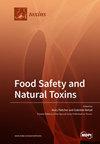Thermoregulation Effects of Phoneutria nigriventer Isolated Toxins in Rats
IF 3.9
3区 医学
Q2 FOOD SCIENCE & TECHNOLOGY
引用次数: 0
Abstract
Body temperature is primarily regulated by the hypothalamus, ensuring proper metabolic function. Envenomation by Phoneutria nigriventer can cause symptoms such as hypothermia, hyperthermia, sweating, and shivering, all related to thermoregulation. This study aims to analyze and identify components of the venom that affect thermoregulation and to evaluate possible mechanisms. Rats were used for thermoregulation analysis, venom fractionation by gel filtration and reverse-phase chromatography (C18), and sequencing by Edman degradation. The venom exhibited hypothermic effects in rats, while its fractions demonstrated both hypothermic (pool II) and hyperthermic (pool III) effects. Further separations of the pools with C18 identified specific peaks responsible for these effects. However, as the peaks were further purified, their effects became less significant. Tests on U87 human glioblastoma cells showed no toxicity. Sequencing of the most active peaks revealed masses similar to those of the Tachykinin and Ctenotoxin families, both known to act on the nervous system. The study concludes that molecules derived from venom can act synergistically or antagonistically. Additionally, toxins that affect thermoregulation are poorly studied and require further characterization. These toxins could potentially serve as sources for the development of new thermoregulatory drugs.Phoneutria nigriventer 分离毒素对大鼠体温调节的影响
体温主要由下丘脑调节,以确保正常的新陈代谢功能。Phoneutria nigriventer 的毒液可导致低体温、高体温、出汗和颤抖等症状,这些症状都与体温调节有关。本研究旨在分析和确定毒液中影响体温调节的成分,并评估可能的机制。研究人员利用大鼠进行体温调节分析,通过凝胶过滤和反相色谱法(C18)对毒液进行分馏,并通过埃德曼降解法对毒液进行测序。毒液对大鼠有降温作用,而其馏分则同时具有降温(池 II)和升温(池 III)作用。用 C18 进一步分离毒液池,发现了导致这些效应的特定峰值。不过,随着峰值的进一步纯化,它们的作用也变得不那么显著了。在 U87 人类胶质母细胞瘤细胞上进行的测试表明没有毒性。对最活跃的峰值进行测序后发现,其质量类似于Tachykinin和Ctenotoxin家族的物质,而这两种物质都已知会对神经系统产生作用。研究得出的结论是,从毒液中提取的分子可以发挥协同或拮抗作用。此外,对影响体温调节的毒素研究较少,需要进一步确定其特征。这些毒素有可能成为开发新体温调节药物的来源。
本文章由计算机程序翻译,如有差异,请以英文原文为准。
求助全文
约1分钟内获得全文
求助全文
来源期刊

Toxins
TOXICOLOGY-
CiteScore
7.50
自引率
16.70%
发文量
765
审稿时长
16.24 days
期刊介绍:
Toxins (ISSN 2072-6651) is an international, peer-reviewed open access journal which provides an advanced forum for studies related to toxins and toxinology. It publishes reviews, regular research papers and short communications. Our aim is to encourage scientists to publish their experimental and theoretical results in as much detail as possible. There is no restriction on the length of the papers. The full experimental details must be provided so that the results can be reproduced.
 求助内容:
求助内容: 应助结果提醒方式:
应助结果提醒方式:


